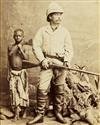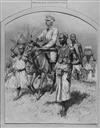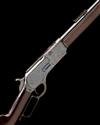- Joined
- Sep 12, 2010
- Messages
- 15,979
- Reaction score
- 51,720
- Location
- Zambia
- Website
- www.takerireservezambia.com
- Deals & offers
- 26
- Media
- 360
- Articles
- 24
- Member of
- sci int,wpaz, PGOAZ
- Hunted
- zambia, tanzania, zimbabwe,Mozambique ,hungary, france, england
Holts auctioneers in the uk have stanleys winchester 1886 rifle for sale .
http://auctions.holtsauctioneers.com/asp/fullcatalogue.asp?salelot=A1215 945 &refno= 93284&utm_source=TurboSMTP&utm_medium=TurboSMTP&utm_term=TurboSMTP&utm_content=TurboSMTP&utm_campaign=TurboSMTP
Full Details for Lot 945













Fine Modern & Antique Guns - December 2015
Jump to Lot :
Sale A1215 Lot 945
FORMERLY THE PROPERTY OF HENRY MORTON STANLEY
WINCHESTER REPEATING ARMS
A .45-75 LEVER-ACTION RIFLE RETAILED BY WATSON, LONDON, 'MODEL 1876 (2nd MODEL)', serial no. 8512,
for 1879, with 28in. blued barrel signed 'WINCHESTER'S REPEATING ARMS. NEW HAVEN. CT.' with King's Improvement patent dates and signed 'WATSON. 4. PALL MALL. LONDON.', blade fore-sight, rear-sight calibrated to 1,000 yards and marked '1876', blued action with sliding dust-cover, hammer and lever each retaining some faint original case-hardened finish, walnut straight-hand butt-stock with crescent heel-plate and sliding trap-cover containing a Winchester four-piece cleaning rod, blued full-length tubular magazine, the whole retaining a fair amount of original blued finish.
Provenance: Holt's Sale 1030, of 17th September 2009, Lot 999 (£35,000) and
Henry Morton Stanley.
The Stanley Trust.
Christie's London, The Africa Sale, 24 September 2002, Lot 55.
Other Notes: "Dr. Livingstone, I presume?"
Henry Morton Stanley, a Welsh-born journalist turned African explorer working for the New York Herald, uttered it on the shores of Lake Victoria in 1872 on meeting the missionary Dr. Livingstone who the world had assumed lost in 'Darkest Africa'. Finding him was the journalistic coup of that decade and this adventure was the start of Stanley's career as an explorer, his greatest achievements being the mapping of the River Congo; the settlement of the Congo basin on behalf of Leopold, King of the Belgians; and the search for Emin Pasha - upon which adventures this rifle accompanied him.
This Winchester rifle here was part of Stanley's personal arsenal and represents a tangible and provocative link to the exploration of Africa in the late nineteenth century. Its charisma is enhanced by the desperately dangerous expeditions on which they were carried. Wild animals and the local inhabitants were dangerous enough, but there was an 80% chance that an explorer would be more likely to be killed by disease. Yet Stanley had a steady number of enquiries from young men who were willing to pay to accompany him on his subsequent expeditions, so great was the fame to be gained on successful African exploration.
Stanley records in his 1872 book 'How I Found Livingstone':
"For the rifle for the larger game the best guns are the English Lancaster and Reilly rifles; and for a fighting weapon the best yet invented is the American Winchester repeating rifle or the "sixteen shooter" as it is called, supplied with the London Eley's ammunition".
This rifle was supplied to Stanley as part of the equipping of the Congo Free State venture and was used by him for the next ten years in the Congo and on the Emin Pasha Relief Expedition (1886-1890).
Following Stanley's journey across Africa in the years 1874 to 1877, during which he mapped the course of the Congo River, King Leopold of Belgium summoned him and persuaded him to take an expedition to the Congo to set up an administration on behalf of Belgian interests.
He arrived at the mouth of the Congo on August 14th 1879 and established his first station at Vivi, 110 miles from the sea, up river. In five years he built roads and set up twenty two garrison stations, put steamboats on the river and set up a political and commercial network.
This work was not without incident, however, and constant conflict with local tribes people, other explorers and wild animals meant that the expedition was well armed. The power of the .45-75 cartridge and the potential rapidity of fire made the Winchester a good choice for the leader of the enterprise, while the native troops were armed with the slower firing Snider rifle.
Stanley writes about this rifle in his two books "Founding of the Congo Free State" and "In Darkest Africa - the Emin Pasha Relief Expedition", and in one case relates a specific incident where the rifle may have saved the expedition when at its weakest from annihilation by a local tribe.
In the Autumn of 1886 Stanley was asked by the British Government to mount an expedition to rescue Emin Bey, governor of Sudan's Equatorial Province who was being threatened by the Mahdi following the death of General Gordon at Khartoum. Stanley, however, also owed loyalty to King Leopold of Belgium and so was persuaded to use the Congo River as the route to reach Lake Albert in what is now Uganda where Emin Pasha was surrounded.
He took seven European officers, sixty one Sudanese soldiers, thirteen Somalis and six hundred porters but travelling up the unexplored Aruwimi River the expedition ran into many hazards fighting hostile tribes and at one time "they had zigzagged for one hundred and sixty days through the forest without having seen a green field the size of a cottage floor". With every mile the strength of the column was weakened and dissipated. "Disease hung over them like a fog, malaria, dysentery and gangrenous ulcers the size of mushrooms that cut flesh to the bone and filled the camp with the stench of rotting flesh".
With only a small group of men fit enough to carry on Stanley had to split the survivors and leave the worst cases in a base camp, but then disaster struck his small party. "We had been followed all day by a large party of well armed tribesmen who made no secret of their hostile intentions towards us, and with few of us strong enough or able to use a rifle, I realized that any attack from this overwhelming force would be fatal to our endeavours. We were at the limit of our strength. One particularly vociferous native sporting an elaborate headdress and shield appeared to be inciting the rest and so I determined to make an example of him to deter the others. I took my big .45 Winchester rifle and took careful aim at about 150 yards and upon pulling the trigger the rifle did its work. I could not have wished for a more satisfactory result as without their leader the others disappeared into the forest and were no further danger to us".
This, however, was only one incident of many but the revolvers and rifles of the expedition carried were one part of the reason for its successful conclusion.
Please click HERE to view Terms & Conditions.
Estimate £10,000-15,000

http://auctions.holtsauctioneers.com/asp/fullcatalogue.asp?salelot=A1215 945 &refno= 93284&utm_source=TurboSMTP&utm_medium=TurboSMTP&utm_term=TurboSMTP&utm_content=TurboSMTP&utm_campaign=TurboSMTP
Full Details for Lot 945













Fine Modern & Antique Guns - December 2015
Jump to Lot :
Sale A1215 Lot 945
FORMERLY THE PROPERTY OF HENRY MORTON STANLEY
WINCHESTER REPEATING ARMS
A .45-75 LEVER-ACTION RIFLE RETAILED BY WATSON, LONDON, 'MODEL 1876 (2nd MODEL)', serial no. 8512,
for 1879, with 28in. blued barrel signed 'WINCHESTER'S REPEATING ARMS. NEW HAVEN. CT.' with King's Improvement patent dates and signed 'WATSON. 4. PALL MALL. LONDON.', blade fore-sight, rear-sight calibrated to 1,000 yards and marked '1876', blued action with sliding dust-cover, hammer and lever each retaining some faint original case-hardened finish, walnut straight-hand butt-stock with crescent heel-plate and sliding trap-cover containing a Winchester four-piece cleaning rod, blued full-length tubular magazine, the whole retaining a fair amount of original blued finish.
Provenance: Holt's Sale 1030, of 17th September 2009, Lot 999 (£35,000) and
Henry Morton Stanley.
The Stanley Trust.
Christie's London, The Africa Sale, 24 September 2002, Lot 55.
Other Notes: "Dr. Livingstone, I presume?"
Henry Morton Stanley, a Welsh-born journalist turned African explorer working for the New York Herald, uttered it on the shores of Lake Victoria in 1872 on meeting the missionary Dr. Livingstone who the world had assumed lost in 'Darkest Africa'. Finding him was the journalistic coup of that decade and this adventure was the start of Stanley's career as an explorer, his greatest achievements being the mapping of the River Congo; the settlement of the Congo basin on behalf of Leopold, King of the Belgians; and the search for Emin Pasha - upon which adventures this rifle accompanied him.
This Winchester rifle here was part of Stanley's personal arsenal and represents a tangible and provocative link to the exploration of Africa in the late nineteenth century. Its charisma is enhanced by the desperately dangerous expeditions on which they were carried. Wild animals and the local inhabitants were dangerous enough, but there was an 80% chance that an explorer would be more likely to be killed by disease. Yet Stanley had a steady number of enquiries from young men who were willing to pay to accompany him on his subsequent expeditions, so great was the fame to be gained on successful African exploration.
Stanley records in his 1872 book 'How I Found Livingstone':
"For the rifle for the larger game the best guns are the English Lancaster and Reilly rifles; and for a fighting weapon the best yet invented is the American Winchester repeating rifle or the "sixteen shooter" as it is called, supplied with the London Eley's ammunition".
This rifle was supplied to Stanley as part of the equipping of the Congo Free State venture and was used by him for the next ten years in the Congo and on the Emin Pasha Relief Expedition (1886-1890).
Following Stanley's journey across Africa in the years 1874 to 1877, during which he mapped the course of the Congo River, King Leopold of Belgium summoned him and persuaded him to take an expedition to the Congo to set up an administration on behalf of Belgian interests.
He arrived at the mouth of the Congo on August 14th 1879 and established his first station at Vivi, 110 miles from the sea, up river. In five years he built roads and set up twenty two garrison stations, put steamboats on the river and set up a political and commercial network.
This work was not without incident, however, and constant conflict with local tribes people, other explorers and wild animals meant that the expedition was well armed. The power of the .45-75 cartridge and the potential rapidity of fire made the Winchester a good choice for the leader of the enterprise, while the native troops were armed with the slower firing Snider rifle.
Stanley writes about this rifle in his two books "Founding of the Congo Free State" and "In Darkest Africa - the Emin Pasha Relief Expedition", and in one case relates a specific incident where the rifle may have saved the expedition when at its weakest from annihilation by a local tribe.
In the Autumn of 1886 Stanley was asked by the British Government to mount an expedition to rescue Emin Bey, governor of Sudan's Equatorial Province who was being threatened by the Mahdi following the death of General Gordon at Khartoum. Stanley, however, also owed loyalty to King Leopold of Belgium and so was persuaded to use the Congo River as the route to reach Lake Albert in what is now Uganda where Emin Pasha was surrounded.
He took seven European officers, sixty one Sudanese soldiers, thirteen Somalis and six hundred porters but travelling up the unexplored Aruwimi River the expedition ran into many hazards fighting hostile tribes and at one time "they had zigzagged for one hundred and sixty days through the forest without having seen a green field the size of a cottage floor". With every mile the strength of the column was weakened and dissipated. "Disease hung over them like a fog, malaria, dysentery and gangrenous ulcers the size of mushrooms that cut flesh to the bone and filled the camp with the stench of rotting flesh".
With only a small group of men fit enough to carry on Stanley had to split the survivors and leave the worst cases in a base camp, but then disaster struck his small party. "We had been followed all day by a large party of well armed tribesmen who made no secret of their hostile intentions towards us, and with few of us strong enough or able to use a rifle, I realized that any attack from this overwhelming force would be fatal to our endeavours. We were at the limit of our strength. One particularly vociferous native sporting an elaborate headdress and shield appeared to be inciting the rest and so I determined to make an example of him to deter the others. I took my big .45 Winchester rifle and took careful aim at about 150 yards and upon pulling the trigger the rifle did its work. I could not have wished for a more satisfactory result as without their leader the others disappeared into the forest and were no further danger to us".
This, however, was only one incident of many but the revolvers and rifles of the expedition carried were one part of the reason for its successful conclusion.
Please click HERE to view Terms & Conditions.
Estimate £10,000-15,000















 , but ammo could be slightly hard to get.....and no reloading even if i did.
, but ammo could be slightly hard to get.....and no reloading even if i did. 

